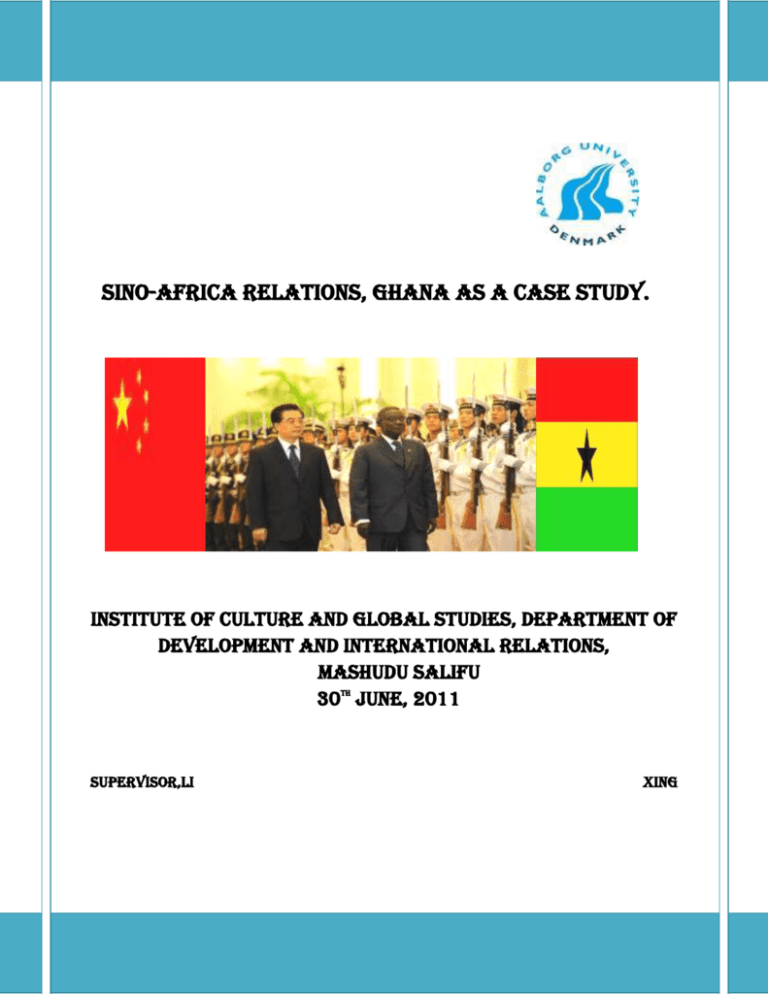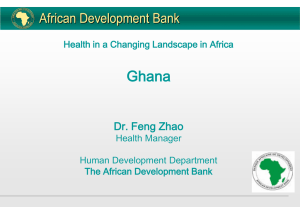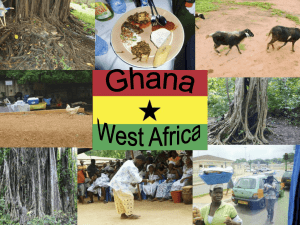SINO-AFRICA RELATIONS, GHANA AS A CASE STUDY.
advertisement

SINO-AFRICA RELATIONS, GHANA AS A CASE STUDY. INSTITUTE OF CULTURE AND GLOBAL STUDIES, DEPARTMENT OF DEVELOPMENT AND INTERNATIONAL RELATIONS, MASHUDU SALIFU 30TH June, 2011 SUPERVISOR,LI xing Table of Content 1.0 CHAPTER ONE…………………………………………………...............................................1 1.1 Introduction……………………………………………………………………………………………………………...1 1.2 Problem Statement………………………………………………………………………………...............3 CHAPTER TWO………………………………………………………………………………………………………………...........7 2.1 Methodology…………………………………………………………………...........7 2.2 Ontological Consideration……………………………………………………………………….....8 2.3 Case Study………………………………………...................................................8 2.4 Research Strategies……………………………………………………………………………………...9 2.5 Areas of Analysis…………………………………………………………………………................10 2.6 Sources of Data……………………………………………………………………………………...........11 2.7 Use of Theory..................................................................................................12 2.8 Limitation of the Study..............................................................................15 CHAPTER THREE 3.0Theories.......................................................................................................16 3.1 Theoretical Consideration..............................................................................16 3.2 Dependency theory.......................................................................................................16 3.3 Application of the Theory.....................................................................................20 3.4 Criticism of the Theory............................................................................................22 3.5 World System theory..............................................................................................23 3, 6 Application of the World System Theory....................................................26 3.7 Criticism of the World System Theory......................................................28 3.8 Chinese Development Model/Approach....................................................29 3.9 Application of the Chinese Development Approach...................................33 3.9.1 Criticism of the Chinese Development Approach.....................................35 CHAPTER FOUR.........................................................................................................................36 4.0 ANALYSIS...........................................................................................................................36 4.1 Introduction of the Analysis......................................................................................36 4.1 Profile of Ghana...........................................................................................................37 4.2 Sino-Ghana Relations..............................................................................................38 4.3 Bandung Period 1955-1960...........................................................................39 4.4 Age of Business......................................................................................................41 4.5 Analysis Diagram...........................................................................................42 4.6 Trade, Trends of Sino-Ghana Exports and Imports.........................43 4.7 Opportunities in Sino-Ghana Trade Relations...........................................46 4.8 Challenges in Sino-Ghana Trade Relations....................................................49 4.9.1 Aid/Economic Development and Technical Assistance.......................53 4.9.2 Categories of Chinese Aid to Ghana ..................................................................54 4.9.3 Joint Venture Partnership...............................................................................56 4.9.4 Other Infrastructural Project that Attracted Chinese Aid.................56 4.9.5 National Communication Project..................................................................57 4.9.6 ICT Development..................................................................................................57 4.9.7 Hydro-Electric Dam project.......................................................................................58 4.9.8 Rail Transport and General Development....................................................58 CHAPTER FIVE 5.1Conclusion and Perspectives......................................................................................63 References................................................................................................................................66 , List of Figures, Maps and Tables. Fig 1, An Outline of the Main Steps of the Research Fig 2 Theories Diagram Fig 3 Dependency Relations with the Chinese Alternatives in the Sino-Ghana Relationship. Fig 4 World System Theoretical Diagram Fig 5 Sino-Ghana Relationship in the Context of Global Economy Fig 6 Key Features of the Chinese Development Model Map1 Map of Ghana Fig 7 Structure of the Analysis Fig 8 Ghana’s Imports by Country of Origin 2003-2008 Fig 9 Ghana Manufactured Goods Imports 200-2006 Fig 10 Sectoral Break down of Chinese FDI in Ghana, 200-2008 (Excluding the 2007 134 million dollars in Manufacturing for Suson Asogli Power Ghana Ltd Project Table 1 A Representation of Some the Loans and Grants from China to Ghana 1995-2006 Table 2 Sino-Ghana Concessionary Loan Agreements for Various Infrastructural Projects in Ghana. Dedication I sincerely dedicated this piece of work to my mother Abukari Fati and Father Mohammed Salifu for their parental love care and support over the years. Acknowledgement I wish to first and foremost, give thanks to God for His endless guidance and protection throughout the work. With God I had the good health, courage and wisdom to undertake the research and writing of the thesis. I however, owe the completion of this study to my supervisor Professor Xing Li whose continuous suggestions, provision of relevant materials upon request, mentorship and inspiration made the work come to a successful conclusion. My deepest gratitude goes also to the Danish Government and the Department of Development and International Relations for the financial support offered me under the limited scholarship scheme during the period of my studies in Aalborg University. I wish to equally express my heartfelt gratitude to all lecturers of my study Department for helping me to further unearth and shape my intellectual capacities to another level. The structure of the course and the teaching style has developed my skills towards a problem base learning. My final sincere acknowledgements go to my immediate family and all friends for their love, support and encouragement before and during the writing of the thesis. June 30th 2011 MASHUDU SALIFU. e-mail address, mash45@hotmail.co.uk. Abstract, Sino-Africa engagement/relationship has grown from strength to strength over the last two decades. This relationship has been viewed by many as one of the visible transformations between the world biggest but fastest growing country and the biggest but poorest developing continent. The main ingredients characterizing the exponential growing relationship inter alia include; bilateral Trade, Investments and Aid, which is informed by the fact that China and Africa have something’s to offer in these areas. The aim of this study is to look at how Sino/Ghana relationship presents opportunities and constraints for Ghana’s quest for a sustainable development paradigm. To achieve this, the study has employed a qualitative research method together with the world system theories, dependency and the Chinese development approach to generate an understanding and shared meaning regarding the question. The study indeed, revealed some opportunities and anxieties for Ghana’s quest for a sustainable development paradigm. Some of the constraints uncovered are trade deficits, displacement or out competing some local businesses from the markets especially the textile and furniture firms, the use of more Chinese labor at the expense of Ghanaians and complains of China not strictly following business and environmental laws in the country. On the contrary, the Chinese engagement also brought in employment, cheap manufacturers for the local consumers, investments in more infrastructural projects and funding for Ghanaian students and professionals to have education and skills training in China respectively.








